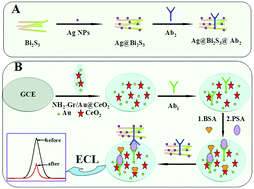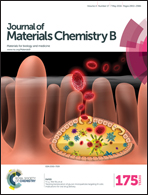A CeO2-matrical enhancing ECL sensing platform based on the Bi2S3-labeled inverted quenching mechanism for PSA detection
Abstract
In this paper, amidogen graphene (NH2-Gr) and Au nanoparticle (NP) functionalized cerium oxide (CeO2) NPs (NH2-Gr/Au@CeO2) have been synthesized. The prepared NH2-Gr/Au@CeO2 exhibits strong electrochemiluminescence (ECL) activity which could be quenched efficiently by bismuth sulfide (Bi2S3). Based on this principle, a novel sandwich ECL immunosensor was constructed for the detection of prostate specific antigen (PSA). NH2-Gr was used as a loading matrix for CeO2 NPs because of its superior conductivity and a large surface area. Au NPs were used to combine anti-PSA 1 (Ab1) to CeO2via the Au–NH2 covalent bond and meanwhile to enhance the sensitivity of the immunosensor. NH2-Gr/Au@CeO2 was used as the ECL response layer. Ag NP functionalized Bi2S3 was used to label the secondary antibody (Ab2). After a sandwich-type immunoreaction, a remarkable decrease of the ECL signal was observed. The signal-off sensor showed a wide linear range response from 1 pg mL−1 to 10 ng mL−1 with a low detection limit (LOD) of 0.3 pg mL−1. The applicability of the proposed ECL immunosensor was evaluated by detecting PSA in human serum samples.


 Please wait while we load your content...
Please wait while we load your content...